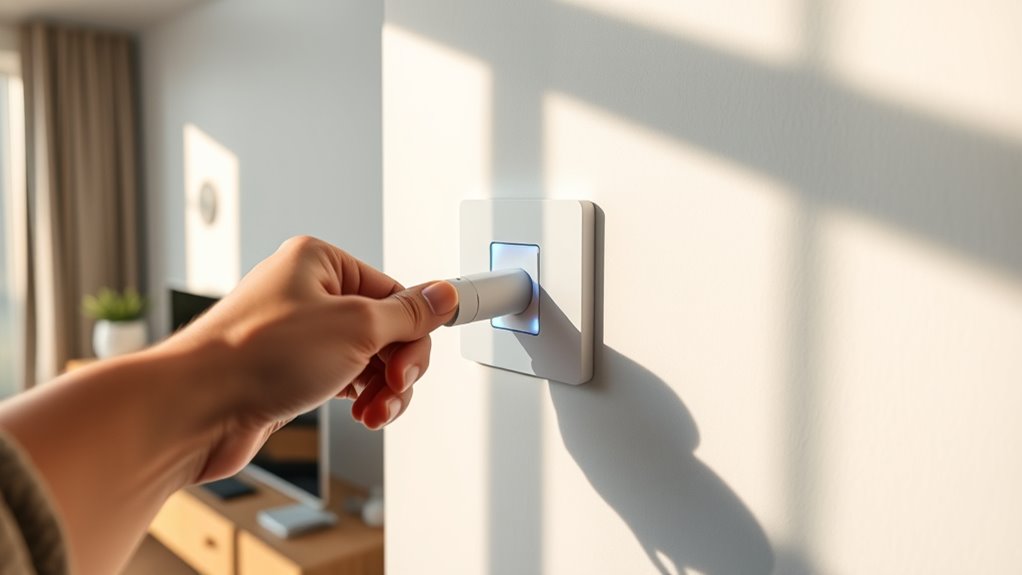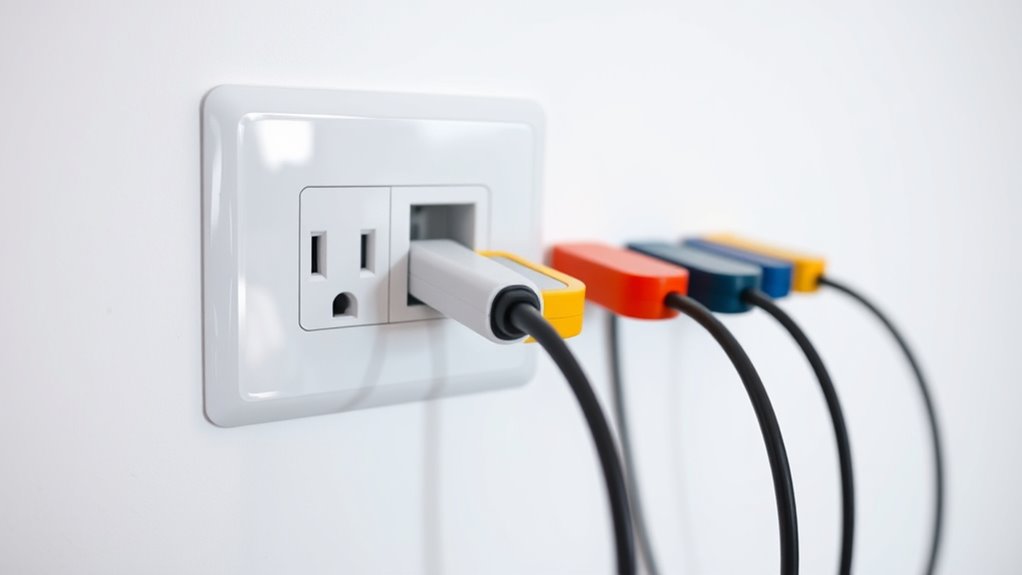To guarantee your new gadgets won’t trip the breaker, start by testing your outlets with a voltage tester or multimeter to check for proper voltage and grounding. Make sure your outlets aren’t warm or tingling, which could indicate grounding issues. Be aware of your circuit’s capacity—avoid plugging too many high-power devices into the same outlet. If you notice irregularities, consider consulting an electrician. Keep going to learn more about safely managing your electrical setup.
Key Takeaways
- Use a circuit tester to verify outlets have proper voltage and grounding before connecting new gadgets.
- Ensure the total load, including new devices, does not exceed the circuit’s maximum capacity.
- Check for signs of grounding issues, such as warmth or tingling sensations, which could cause overloads.
- Test outlets to confirm stable voltage levels, reducing the risk of tripping breakers with new electronics.
- Consult an electrician if irregular readings or grounding problems are detected to prevent electrical hazards.

When you’re trying to determine if an outlet is safe and functioning properly, performing the Outlet Test can save you time and prevent potential hazards. This simple check helps you identify issues like grounding safety concerns or overloading that might cause your circuit to trip. Ensuring proper grounding safety is essential because it directs stray electrical current safely into the ground, protecting you from shocks and preventing damage to your gadgets. If your outlet lacks a proper ground connection, even a minor fault could become dangerous. During the test, look for signs of grounding issues, such as outlets that feel warm or produce a tingling sensation when touched. Using a tester designed for grounding checks can quickly confirm whether the outlet is grounded correctly. Additionally, understanding the contrast ratio of your electrical system can help you gauge how well your outlet manages different loads and lighting conditions. Another crucial aspect to contemplate is circuit capacity. Every circuit has a maximum load it can handle safely, often marked on the breaker itself. If you plug in multiple high-powered devices or new gadgets that draw more current than the outlet’s capacity, you risk overloading the circuit, which can trip the breaker or, worse, cause an electrical fire. The Outlet Test can help assess whether your outlet is operating within its capacity by checking for consistent power flow and proper voltage levels. If you notice the breaker trips frequently when adding new devices, it’s a sign that your circuit capacity might be exceeded. In such cases, redistributing your devices across different outlets or upgrading your electrical system may be necessary.
Performing the Outlet Test involves using simple tools like a circuit tester or a multimeter. These devices can quickly verify voltage levels, grounding, and wiring integrity. When testing, insert the tester into the outlet and observe the indicator lights or read the display. Proper functioning outlets will show a steady voltage within the standard range (around 120V in most homes). An inconsistent reading or unusual pattern can signal wiring problems, grounding safety issues, or that the circuit is nearing its limit. If the test reveals any irregularities, it’s best to consult a qualified electrician to troubleshoot further or upgrade your electrical system.
Frequently Asked Questions
Can I Use the Outlet Test on Outdoor Electrical Devices?
You can use the outlet test on outdoor outlets, but make sure it’s a weatherproof connection. First, check that the outdoor outlet is properly protected with a cover designed for weather exposure. Then, plug in your device and turn it on. If it works smoothly without tripping the breaker, you’re good to go. Always prioritize weatherproof connections for outdoor electrical devices to prevent shocks or damage.
How Often Should I Perform the Outlet Test?
Ironically, you might think testing your outlet is a one-time deal, but power consumption varies, so testing frequency is key. You should perform the outlet test at least once every six months to catch any issues early. If you notice flickering lights or appliances shutting off unexpectedly, increase testing. Regular checks guarantee your outlets handle the current load safely, preventing surprises and keeping your home powered smoothly.
What Safety Precautions Are Necessary During Testing?
When testing outlets, you should take safety precautions like ensuring proper grounding safety and using tested, reliable testing equipment. Always turn off the power before starting, and double-check that your tester is in good condition. Keep your hands dry, stand on a dry surface, and avoid testing in wet conditions. If unsure, consult a professional to prevent electric shocks or damage, prioritizing safety during every test.
Are There Specific Outlets Better Suited for High-Power Gadgets?
Think of your outlets as the gateways to power, and some are better suited for high-power gadgets than others. You should look for outlets with higher capacity and verify circuit compatibility to prevent overloads. For heavy-duty devices, dedicated outlets are like VIP lanes, designed to handle the load without tripping the breaker. Always check the outlet’s capacity before plugging in those power-hungry gadgets to keep your home running smoothly.
What Should I Do if My Outlet Fails the Test?
If your outlet fails the test, you should unplug all devices immediately to prevent overload and possible grounding issues. Avoid using the outlet until a qualified electrician checks it, ensuring proper grounding and safe operation. They can diagnose and fix grounding problems or upgrade your wiring if needed. This step helps prevent tripping breakers, electrical fires, and damage to your gadgets, keeping your home safe and functional.
Conclusion
By testing your outlets, by checking your gadgets, and by staying aware of your home’s electrical needs, you protect your devices, prevent potential hazards, and keep your home safe. The outlet test is simple, the precautions are easy, and the peace of mind is priceless. So, stay vigilant, stay safe, and make sure your outlets are ready for anything. After all, a little effort today keeps the power flowing smoothly tomorrow.









